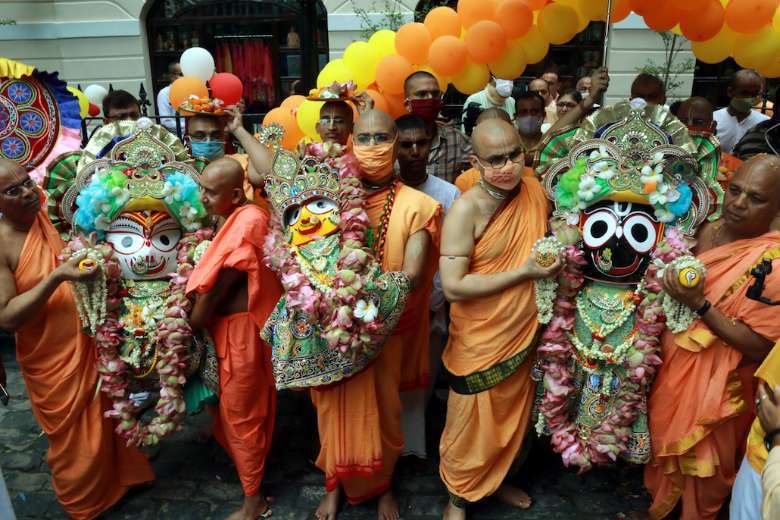The age-old debate on conversion continues with the same passion, tone and argument even today


Hindu priests and devotees carry an idol of Lord Jagannath as a symbolic gesture after a Rath Yatra procession was canceled amid Covid-19 restrictions in Kolkata, India, on July 12. (Photo: AFP)
An upper-caste Hindu boy, Narayan Sesadri Parlikar, joined a school run by the Church of Scotland in Bombay way back in 1838. Five years later in 1843, he converted to become a Christian.
The Bombay Courier, the leading English daily of the time, published a column-length story on Parlikar’s conversion, triggering a major upheaval among the city’s upper-caste Hindu society.
The day after his conversion, the outraged members of Brahmin priestly caste, to whom the boy belonged, passed a resolution censuring the event.
“The missionaries of Christian faith … distribute books on their dharma (religion). In order to facilitate their efforts, they have established schools. For the sake of education, Hindu boys join their schools. The boys are immature in their understanding of Hindu dharma. Their minds become confused, and many have been converted to Christianity,” the resolution said.
The 19th-century debate on religious conversion continues with the same passion, tone, and argument even today. The parties in the debate haven’t progressed much in understanding each other’s claims on the contentious issue of conversion that keeps surfacing in politics, media and courts.
Those who want to outlaw conversion argue that a change of religion disturbs social peace in a pluralistic country, but those who support it present conversion as a fundamental human right guaranteed by the Indian constitution.
This survey, though, finds that religious switching, or conversion, has a minimal impact on the overall size of India’s religious groups
The positions have remained unchanged for centuries, but the heated discussions have progressively raised feelings of mutual distrust, unease and resentment between Hindus and minority Christians and Muslims.
As yet, no amount of research has presented conclusive answers to the debate on conversion.
The common Indian tends to believe in the logic that there cannot be smoke without fire, meaning even rumors must be at least partly true.
The claims of conversion changing demographics and creating social disturbances must be more smoke than fire, according to the latest findings of a Pew Research Center survey of religion across India.
“Religious groups show little change in size due to conversion,” says the survey based on nearly 30,000 face-to-face interviews of adults conducted in 17 languages between late 2019 and early 2020.
“This survey, though, finds that religious switching, or conversion, has a minimal impact on the overall size of India’s religious groups,” said the Pew report titled “Religion in India: Tolerance and Segregation.”
It noted that as many as nine Indian states have enacted laws against proselytism as of 2021, with half of Indians supporting a legal ban on conversions.
Hindu communities are not losing any members because of conversion, the survey said.
For example, 82 percent of Indians said they were raised Hindu, while a nearly identical share said they will remain Hindu, showing no net losses through conversion to other religions. Other religious groups displayed similar levels of stability.
“Changes in India’s religious landscape over time are largely a result of differences in fertility rates among religious groups, not conversion,” the Pew report said.
But unlike the others, Christians recorded a little net gain from conversion: 0.4 percent of survey respondents were former Hindus who now identify as Christian, while 0.1 percent were former Christians.
This could be enough to raise the hackles of the proponents of Hindutva, who view conversion as a security threat with the potential to destabilize the nation.
Even Mahatma Gandhi was concerned over conversions and wrote that “India stands in no need of conversions from one faith to another.”
The issue also featured during the debates of the Constituent Assembly, convened to discuss and approve India’s constitution, with members warning the gradually diminishing Hindu population might lead to calls for a “separate nation.”
The focus of Hindu nationalists has moved to combating the conversion threat through legal means
It is to the credit of India’s constitution makers that the country firmly enshrined not just the citizens’ freedom to “practice” but also to “propagate” a religion of their choice as a fundamental right.
And yet the debate continues, and not surprisingly.
More recently, it was Atal Bihari Vajpayee, a former prime minister belonging to the pro-Hindu Bharatiya Janata Party (BJP), calling for a national debate on conversion in the midst of raging violence against Christians in states like Gujarat, Madhya Pradesh, Rajasthan and Orissa.
The BJP first rose to power in 1998 with Vajpayee at the helm of a coalition government in New Delhi. It led to enactment or amendment of anti-conversion legislation in six states during the following decade ending 2008.
One among these states was Gujarat, which was headed by sitting Prime Minister Narendra Modi. Since his rise to power nationally, there has been a marked shift in the anti-conversion campaign conducted by right-wing nationalists.
The fierce violence like the Dangs Church in Gujarat witnessed in 1998 or the burning alive of Graham Staines and his two sons in 1999 may have ebbed, perhaps because the BJP now enjoys a single-party majority in the national parliament and leads governments in Goa and a few other states known for sizeable Christian votes.
The focus of Hindu nationalists has moved to combating the conversion threat through legal means while also adopting sly, sophisticated methods to starve Christian organizations of foreign funds and personnel.
Anti-conversion laws have been enacted by BJP governments in the states of Uttar Pradesh, Himachal Pradesh and Madhya Pradesh over the past year, while Haryana, Karnataka and Punjab are also in the process of drafting similar laws against interfaith marriages.
There is little hope of repealing these laws — often ironically labeled “freedom of religion” laws — with a change in government.
Besides, religious conversion in India remains a potent political tool for consolidating Hindus.
Even liberal journalists tend to be critical of Christianity, believing that missionaries in India lure people with cash or in kind to convert them
Opposition to both religious conversions and interfaith marriages runs deep in Indian society, a fact confirmed by the Pew report.
Even liberal journalists tend to be critical of Christianity, believing that missionaries in India lure people with cash or in kind to convert them.
Last year, when India’s home ministry suspended the licenses of some Christian groups under the Foreign Contribution Regulation Act, or FCRA, senior journalist-author Dilip Mandal wrote: “In India, Christianity has never been a liberation theology. Spending money or doing social work or helping people in need to proselytise them is in itself an immoral act and no god will perhaps approve of this act.”
He further charged the followers of Christ of “becoming a tool for Brahmins, elites” and failing to “transcend the barrier of caste.”
Mandal’s main grouse appears to be that Christian schools taught the likes of BJP leaders like Lal Krishna Advani, J.P. Nadda, Arun Jaitley, Piyush Goyal, Vasundhara Raje rather than the millions of poor Dalits and tribal kids denied education for centuries by an unjust Hindu caste system.
“A government led by a party whose president J.P. Nadda had his education at St. Xavier’s School clamping down on the financial sources of Christian missionary activities is the poetic justice happening to Indian Christianity,” he wrote.
Does this argument hold when the Pew survey reveals that “the vast majority of former Hindus who are now Christian belong to scheduled (low) castes (48 percent), scheduled tribes (14 percent) or other backward classes (26 percent)”?
It is true that the majority of India’s Christians, just over 2 percent of the national population, are a result of conversions administered by foreign missionaries. But lest we forget, Christianity in India predates the arrival of European missionaries in the 16th century.
Its legacy is not a handful of Indians calling themselves Catholics or Protestants. It is their disproportionate undertaking, whether it is in education, health and voluntary service sectors, or simple acts like caring for orphans, widows and the old.
It is about the women and men who continue to respond to the moral and spiritual calling with their insistence upon the sacredness of every human being as a living temple of God.
The views expressed in this article are those of the author and do not necessarily reflect the official editorial position of UCA News.
